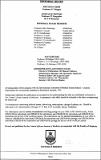| dc.contributor.author | Manji, K.P. | |
| dc.contributor.author | Kisenge, R. | |
| dc.coverage.spatial | Tanzania | en_GB |
| dc.date.accessioned | 2014-10-30T11:53:52Z | |
| dc.date.available | 2014-10-30T11:53:52Z | |
| dc.date.issued | 2003-03 | |
| dc.identifier.citation | Manji, K.P. & Kisenge, P. (2003) Neonatal hypothermia on admission to a special care unit in Dar-es-Salaam, Tanzania: a cause for concern, CAJM Vol. 49, No. 3. Harare, Avondale: CAJM. | en_GB |
| dc.identifier.issn | 0008-9176 | |
| dc.identifier.uri | https://opendocs.ids.ac.uk/opendocs/handle/20.500.12413/4926 | |
| dc.description | A CAJM journal article. | en_GB |
| dc.description.abstract | Objective: To determine the prevalence and risk factors for hypothermia among neonates on admission to the Neonatal Care Unit.
Hypothermia in newborn babies is a problem in tropical countries despite warm environmental conditions and it contributes to a high neonatal morbidity and mortality.
Methodology: A study was undertaken to determine the prevalence of hypothermia and its association with early neonatal outcome among neonates admitted to the Neonatal Care Unit of Muhimbili Medical Centre . At admission all neonates were examined and axillary temperature recorded using a low-reading thermometer. Six-hourly temperature was taken in all infants: Those with a temperature below 36.5°C were recruited as cases and those with normal temperature served as controls. These neonates were followed up for early neonatal outcome.
Results: Hypothermia on admission was found in 366 out of 1632 babies (22.4%). In none of these was hypothermia recorded or reported as a reason for admission. Thirteen percent of the hypothermic neonates had severe hypothermia, with body temperature below 32°C on admission. Hypothermia was significantly associated with deliveries from outside hospitals and with those who had operative or instrumental delivery in the same hospital. It was also associated with prematurity, low birth weight babies, time taken to transfer the baby and inadequate clothing after delivery. It was found that hypothermic infants had a three fold higher mortality and morbidity. These infants had a longer stay in the unit and had a higher post natal weight loss. There was no low-reading thermometer in the unit.
Conclusion: It is concluded that there is cause for concern about hypothermia in the neonates at Muhimbili Medical Centre, Efforts should be made to sensitize and educate all levels of staff dealing with neonates, and low-reading thermometers should be part of the essential kit in the unit. | en_GB |
| dc.language.iso | en | en_GB |
| dc.publisher | Central African Journal of Medicine (CAJM), University of Zimbabwe | en_GB |
| dc.rights.uri | http://creativecommons.org/licenses/by-nc-nd/3.0/ | en_GB |
| dc.subject | Health | en_GB |
| dc.title | Neonatal hypothermia on admission to a special care unit in Dar-es-Salaam, Tanzania: a cause for concern | en_GB |
| dc.type | Article | en_GB |
| dc.rights.holder | University of Zimbabwe | en_GB |


